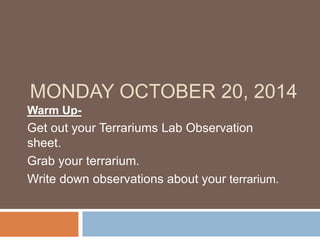
Monday october 20, 2014
- 1. MONDAY OCTOBER 20, 2014 Warm Up- Get out your Terrariums Lab Observation sheet. Grab your terrarium. Write down observations about your terrarium.
- 2. Objective Students will be able to distinguish between a plant cell and an animal cell.
- 3. Plant vs. Animal Mini Poster FINISH Create a way to compare and contrast plant and animal cells. Make sure you include facts about both types of cells. Include how they are similar, as well as how they are different. You may make one of the following… Story Cartoon Diagram Picture Paragraph
- 5. Homework Finish Mini Poster if not done at the end of this class Due tomorrow!! Quiz Wednesday. Study!!! Plant cell vs. Animal cell Photosynthesis
- 6. H Period 10/21 Get caught up on missing work!! See a teacher if you need to!! Work on homework or read quietly
- 7. TUESDAY OCTOBER 21, 2014 Warm Up- List 3 facts about plant and animal cells. Write one question you still have about plant and animal cells.
- 8. Objective Students will be able to identify and apply facts about plant cells, animal cells, and photosynthesis
- 9. Review Packets Fill out as much as you can without using your notes We will go over
- 10. Review packet Page 2 Mitochondria Ribosomes Golgi Body Chloroplasts Cytoplasm Nucleus Cell Wall Rough E.R. Nucleus E.R. Vacuole
- 11. Review Packet Page 3 1. Carbon Dioxide 2. Water 3. Glucose 4. Oxygen 5. Carbon dioxide and water 6. Glucose and oxygen 7. Sunlight provides the energy or the reaction, but is neither a reactant nor a product 8. Inside chloroplasts located in the cells mainly in the stems and leaves of the plant; some algae and bacteria use this as well. 9. Photosynthesis 10. Pigments 11. Chlorophyll 12. Stomata 13. Autotroph 14. heterotroph
- 12. Review Packet Page 4 1. Cytoplasm 2. E.R. 3. Nucleus 4. Mitochondria 5. Cell Membrane 6. Organelles 7. Cell wall 8. Cell membrane 9. Nucleus 10. Cytoplasm 11. Mitochondria 12. E.R. 13. Ribosomes 14. Golgi Body 15. Chloroplasts 16. Vacuole 17. lysosomes
- 13. Mini Posters Share your posters with your group
- 14. Questions???
- 15. WEDNESDAY OCTOBER 22, 2014 Warm Up- 10 minutes to look over notes ***Review Packets will be collected before quiz***
- 16. Objective Students will be able to apply and organize information about plant cells, animal cells, and photosynthesis
- 17. Quiz Take your time. Ask questions if you need to!! Flip your quiz over when you are done Grab something to read
- 18. THURSDAY OCTOBER 23, 2014 Warm Up- What do you think a multicellular organism needs in order to live?
- 19. Objective Students will be able to arrange the different levels of organization within an organism.
- 20. Levels of Organization Read/ highlight the reading Fill out the Levels of Organization Worksheet In your notebooks, define… Cell Tissue Organ Organ System
- 21. FRIDAY OCTOBER 24, 2014 Warm Up- Why do you think multicellular organisms are so complex?
- 22. Change of Schedule C 7:25 – 8:10 D 8:12 – 8:52 A 8:54 – 9:34 E2 9:36 – 10:19 F2 10:21 – 11:03 Lunch 11:05 – 11:25 B 11:27 – 12:10 Assembly 12:15 – 1:15 ADV 1:30 – 2:00
- 23. Objective Students will be able to arrange the different levels of organization within an organism.
- 24. Levels of Organization Always written smallest to largest From the simplest to the most complex Cells Tissues Organs Organ Systems Organism Cells make up tissues Tissues make up organs Organs make up organ systems Organ systems make up an organism
- 25. Cells The basic unit of structure and function of life Carry out the functions that keep organisms alive May serve a specific function within an organism Examples- blood cells, nerve cells, bone cells, skin cells
- 26. Tissues Made up of cells that are similar in structure and function Made up of cells that work together to perform a specific activity 4 types of tissue- connective, epithelial, muscle, nerve Examples- blood, nervous, bone
- 27. Organs Made up of tissues that work together to perform a specific activity Examples- heart, lungs, stomach, brain, skin
- 28. Groups of two or more organs that work together to perform a specific function for the organism 11 systems in the human body Circulatory Respiratory Nervous Digestive Skin (integumentary) Endocrine Excretory (urinary) Immune (lymphatic) Muscular Skeletal Reproductive Organ Systems
- 29. Organism Entire living thing that can carry out all basic life processes Usually made up of organ systems Can be made of one cell (protists, bacteria)
- 35. Exit ticket Write the levels of organization within an organism from smallest to largest, without using any notes. Create an example of an organism and how it has the different levels of organization